Abstract
Enzymatic hydrolysates of various cottonseed flours were prepared with the proteolytic enzymes bromelain, HT-200, Pronase, and trypsin. The growth of various aerobic bacteria of clinical significance in these hydrolysates was compared to that obtained with a standard casein-soybean peptone culture medium, Trypticase soy. The generation times of the majority of bacteria grown in the bromelain cottonseed flour hydrolysate were shorter than that obtained with the standard control broth. A bromelain cottonseed flour hydrolysate agar preparation supported the growth of the bacteria comparably to that of the casein-soybean agar substrate. All the bacterial colonies were larger on the bromelain cottonseed flour hydrolysate blood agar medium than those grown on the control agar. The peptones derived from the enzymatic hydrolysis of cottonseed flour are sufficient to promote the rapid and luxuriant growth of a wide spectrum of aerobic bacteria without the addition of peptone from other sources. It is suggested that cottonseed flour peptones be utilized as a nutrient source in general-purpose media for the clinical microbiology laboratory.
Full text
PDF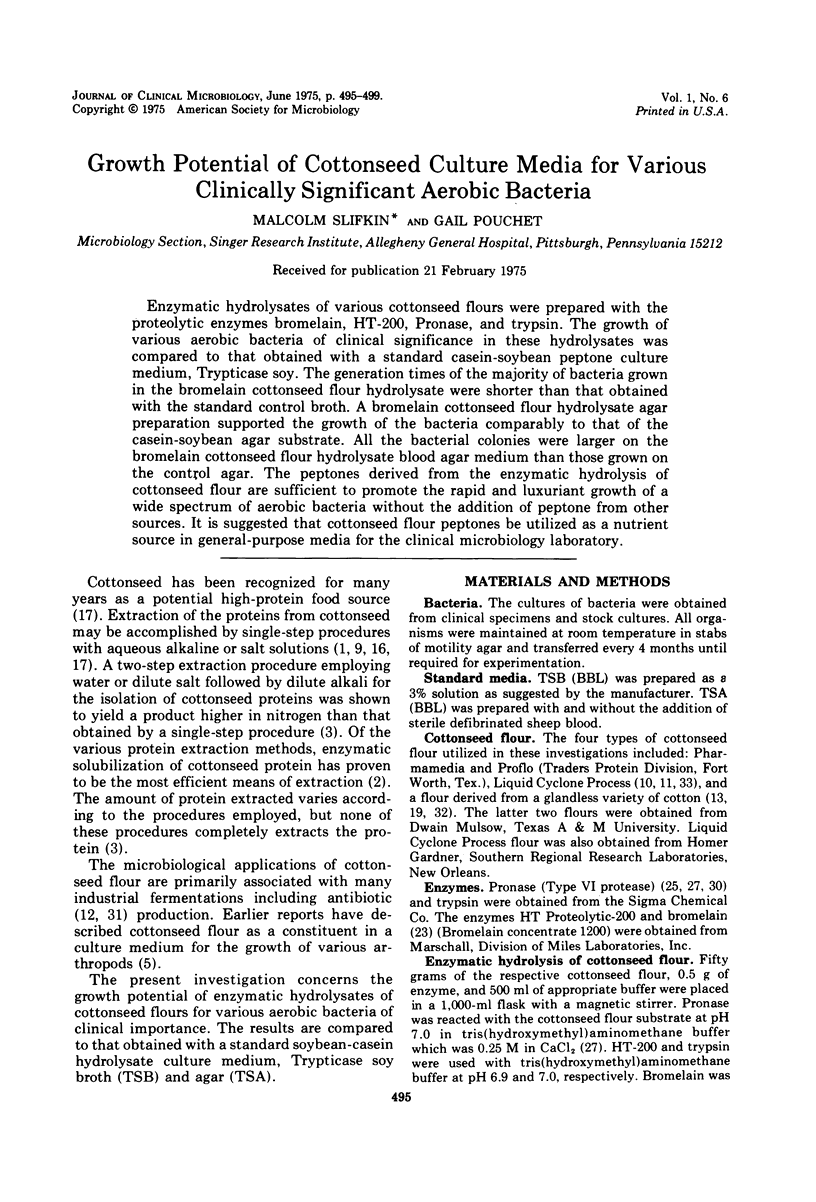
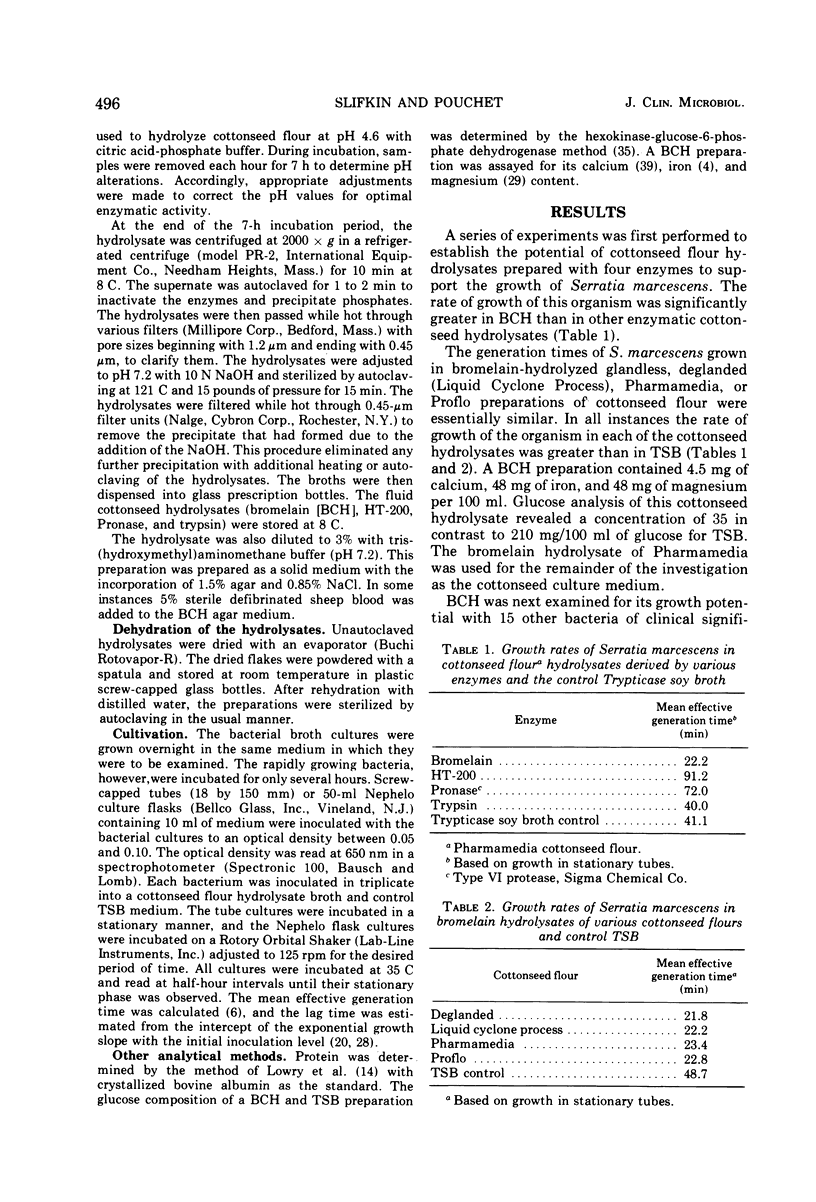
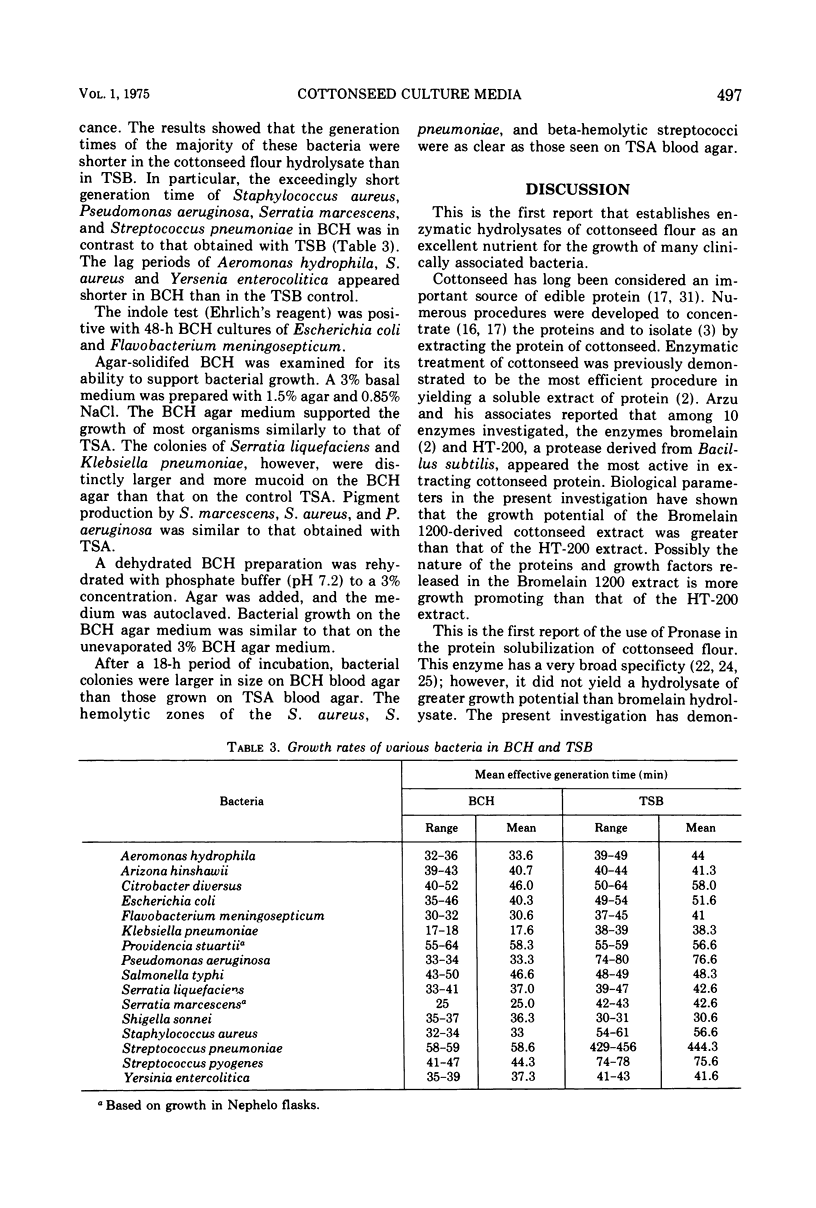
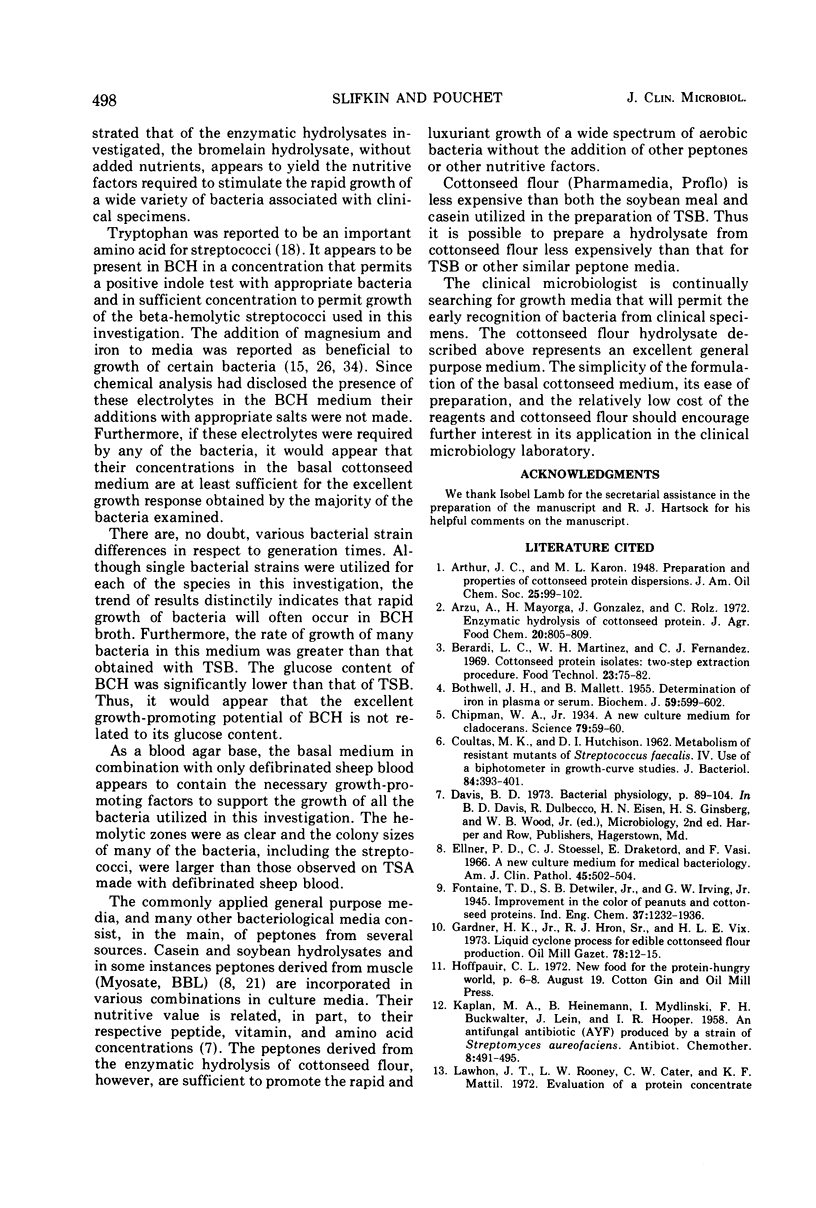
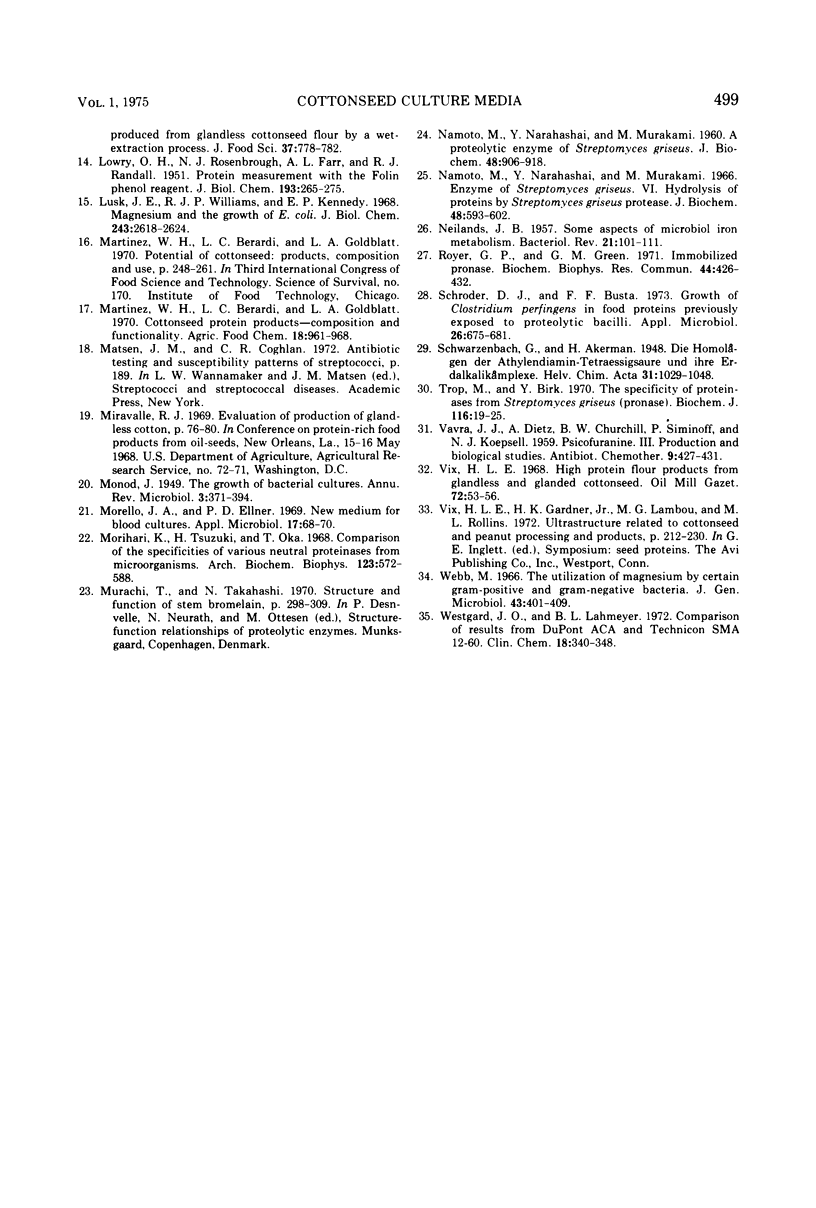
Selected References
These references are in PubMed. This may not be the complete list of references from this article.
- Arzú A., Mayorga H., González J., Rolz C. Enzymatic hydrolysis of cottonseed protein. J Agric Food Chem. 1972 Jul-Aug;20(4):805–809. doi: 10.1021/jf60182a004. [DOI] [PubMed] [Google Scholar]
- BOTHWELL T. H., MALLETT B. The determination of iron in plasma or serum. Biochem J. 1955 Apr;59(4):599–602. doi: 10.1042/bj0590599. [DOI] [PMC free article] [PubMed] [Google Scholar]
- COULTAS M. K., HUTCHISON D. J. Metabolism of resistant mutants of Streptococcus faecalis. IV. Use of a biophotometer in growth-curve studies. J Bacteriol. 1962 Sep;84:393–401. doi: 10.1128/jb.84.3.393-401.1962. [DOI] [PMC free article] [PubMed] [Google Scholar]
- Chipman W. A., Jr A NEW CULTURE MEDIUM FOR CLADOCERANS. Science. 1934 Jan 19;79(2038):59–60. doi: 10.1126/science.79.2038.59. [DOI] [PubMed] [Google Scholar]
- Ellner P. D., Stoessel C. J., Drakeford E., Vasi F. A new culture medium for medical bacteriology. Am J Clin Pathol. 1966 Apr;45(4):502–504. doi: 10.1093/ajcp/45.4_ts.502. [DOI] [PubMed] [Google Scholar]
- LOWRY O. H., ROSEBROUGH N. J., FARR A. L., RANDALL R. J. Protein measurement with the Folin phenol reagent. J Biol Chem. 1951 Nov;193(1):265–275. [PubMed] [Google Scholar]
- Lusk J. E., Williams R. J., Kennedy E. P. Magnesium and the growth of Escherichia coli. J Biol Chem. 1968 May 25;243(10):2618–2624. [PubMed] [Google Scholar]
- Morello J. A., Ellner P. D. New medium for blood cultures. Appl Microbiol. 1969 Jan;17(1):68–70. doi: 10.1128/am.17.1.68-70.1969. [DOI] [PMC free article] [PubMed] [Google Scholar]
- Morihara K., Tsuzuki H., Oka T. Comparison of the specificities of various neutral proteinases from microorganisms. Arch Biochem Biophys. 1968 Mar 11;123(3):572–588. doi: 10.1016/0003-9861(68)90179-3. [DOI] [PubMed] [Google Scholar]
- NEILANDS J. B. Some aspects of microbial iron metabolism. Bacteriol Rev. 1957 Jun;21(2):101–111. doi: 10.1128/br.21.2.101-111.1957. [DOI] [PMC free article] [PubMed] [Google Scholar]
- Royer G. P., Green G. M. Immobilized pronase. Biochem Biophys Res Commun. 1971 Jul 16;44(2):426–432. doi: 10.1016/0006-291x(71)90618-8. [DOI] [PubMed] [Google Scholar]
- Schroder D. J., Busta F. F. Growth of Clostridium perfringens in food proteins previously exposed to proteolytic bacilli. Appl Microbiol. 1973 Nov;26(5):675–681. doi: 10.1128/am.26.5.675-681.1973. [DOI] [PMC free article] [PubMed] [Google Scholar]
- Trop M., Birk Y. The specificity of proteinases from Streptomyces griseus (pronase). Biochem J. 1970 Jan;116(1):19–25. doi: 10.1042/bj1160019. [DOI] [PMC free article] [PubMed] [Google Scholar]
- Webb M. The utilization of magnesium by certain Gram-positive and Gram-negative bacteria. J Gen Microbiol. 1966 Jun;43(3):401–409. doi: 10.1099/00221287-43-3-401. [DOI] [PubMed] [Google Scholar]
- Westgard J. O., Lahmeyer B. L. Comparison of results from the Du Pont "ACA" and Technicon "SMA 12-60". Clin Chem. 1972 Apr;18(4):340–348. [PubMed] [Google Scholar]


